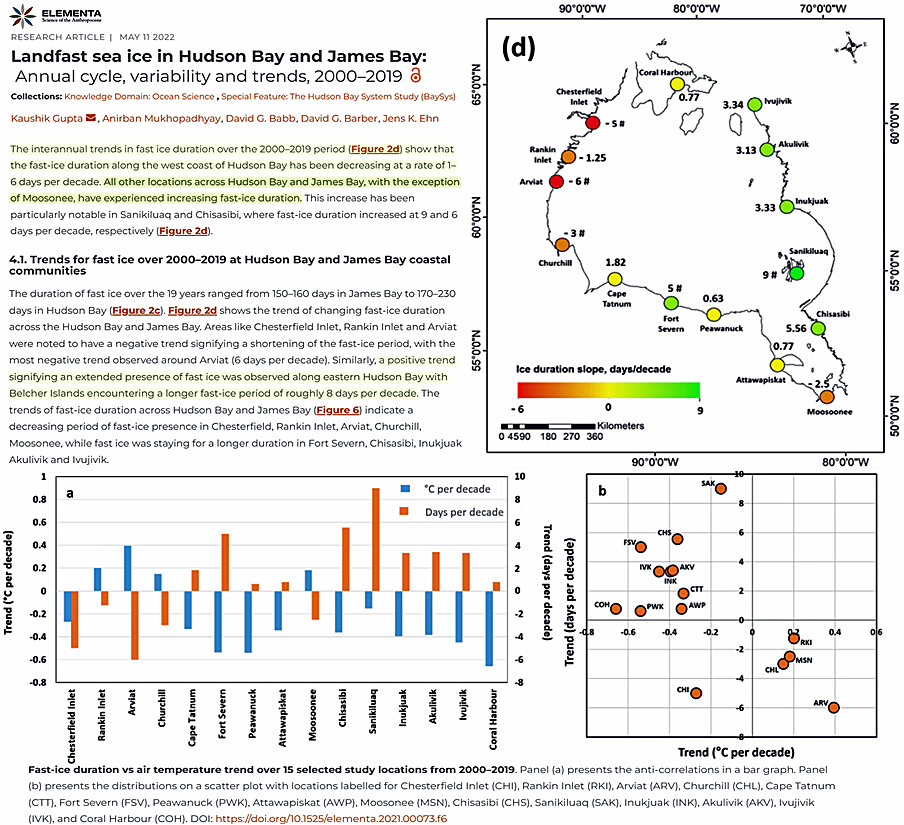A new study (Gupta et al., 2022) indicates that from 2000-2019 73% of the 15 sites considered have been cooling and 67% have experienced a lengthening of sea ice duration.
Canada’s Hudson Bay extends into the Arctic Ocean and its coasts are teeming with polar bears.
Scientists report 11 of 15 Hudson Bay sites have been cooling since 2000. The average cooling for these 11 sites is -0.34°C per decade.

Image Source: Gupta et al., 2022
Cooling °C per decade, 2000-2019
Chesterfield Inlet: -0.25°C
Cape Tatnum: -0.3°C
Fort Severn: -0.5°C
Peawanuck: -0.5°C
Attawapiskat: -0.3°C
Chisasibi: -0.3°C
Sanikiluaq: -0.15°C
Inukjuak: -0.4°C
Akulivik: -0.4°C
Ivujivik: -0.45°C
Coral Harbor: -0.65°C
There are 4 sites that have been warming since 2000, averaging 0.24°C per decade combined.
Warming °C per decade, 2000-2019
Rankin Inlet: 0.2°C
Arviat: 0.4°C
Churchill: 0.15°C
Moosonee: 0.2°C
All 15 sites combined suggest an overall cooling trend of -0.183°C per decade, or -0.35°C, from 2000-2019 for this region.
Of the 11 cooling sites, 10 experienced an expansion of sea ice duration (earlier freeze-ups and/or later break-ups) over the 19-year period.
“The interannual trends in fast ice duration over the 2000–2019 period (Figure 2d) show that the fast-ice duration along the west coast of Hudson Bay has been decreasing at a rate of 1–6 days per decade. All other locations across Hudson Bay and James Bay, with the exception of Moosonee, have experienced increasing fast-ice duration. This increase has been particularly notable in Sanikiluaq and Chisasibi, where fast-ice duration increased at 9 and 6 days per decade, respectively.”





That’s just a temporary blip. All that ice is going to melt any minute now. You watch it. Any minute. Aaany minute …
The time of Polar Bear existence has been claimed to be between 250,000 and 850,000 years. Whatever, they must have survived at least 2 periods of thousands of years of global warming with temperatures above that this present Interglacial (hence less ice).
So these facts will only be accepted is it is said “Good News for Polar Bears. More Ice”.
The green-alarm fanatics (The Climate Cult) had to change the concept of “Global Warming” to “Climate Change”.
The Hudson Bay sites shown will be interpreted as proving “climate change” as the overall warming of “global” is once again shown to be false.
As Susan Crockford ( https://polarbearscience.com/ ) has shown, Polar Bears are doing fine. Activists and agenda driven writers have had to move on to other cute and cuddly critters. Trying to hug a Polar Bear is a bad life-choice decision.
So . . Hudson Bay is cooling, Greenland is cooling [10-yr trend] and the continent of Antarctica is cooling [40-yr trend].
[…] Related: Since 2000 The Arctic’s Hudson Bay Has Cooled -0.35°C With 10 Of 15 Sites Gaining Sea Ice […]
This is consistent with recent North Atlantic cooling that is ongoing.
[…] From the NoTricksZone […]
[…] Dal sito NoTricksZone […]